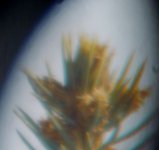Just got some eyepieces.... the Nagler Zoom 6-3mm won't reach infinity focus with the 80HD. It focuses about 100ft like the Pentax. The ones that work are:
TV Nagler 5mm
TV Nagler 3.5mm
TV Radian 3mm
TV Ethos 3.7mm
You might find more by looking at column F in the specs:
http://www.televue.com/engine/TV3_page.asp?id=28
but the zoom is specified in a way that it should have worked if that's all we look at
So the Radian 3mm shows a lot of junk in my eye in daylight observing (dust, floaters, specks etc) The exit pupil ~0.5mm is too small for my eye when there is a light background. For astronomy it's doable, but I think I like the Nagler 3.5mm better because of the slightly larger exit pupil that makes even daylight observing doable and it gives more generous AFOV and is smaller in size. It lacks the 20mm eye relief of the Radian but I find the 12mm acceptable - glasses wearers would prefer the Radian.
For daylight views, the Nagler 5mm is certainly the best. A Radian of this focal length would be equally good with the tradeoff being physical size for eye relief.
The Ethos 3.7 is unique because it has a screw-on 2" adapter so unlike the other Ethos eyepieces with a 2" over-sleeve, it works quite well on the Swarovski. It is a bit long and heavy. I've had Ethos before so I knew what to expect from the 110 degree AFOV. It would be better if it wasn't also so high magnification for this scope. I really believe in the Ethos design idea but some of the benefits are diminished by the fact that with this focal length, the limits of the scope are really be pushed. This would be a great eyepiece for a 10" scope no doubt. In optical terms, I would love to have an Ethos 21 for this 80mm scope but in mechanical terms, it's too big and clunky.
I'll be doing some more observing (I have wind and cumulus clouds playing tricks on me). I did get to see Orion and a crescent moon. I'm hoping for Saturn later tonight.
On star testing, I've not been able to do a good job handholding the eyepiece so far but it appears like I have more contrast of the diffraction rings outside focus than I do inside focus. I don't see any change in the brightness from center out though. I don't see astigmatism or coma either.





